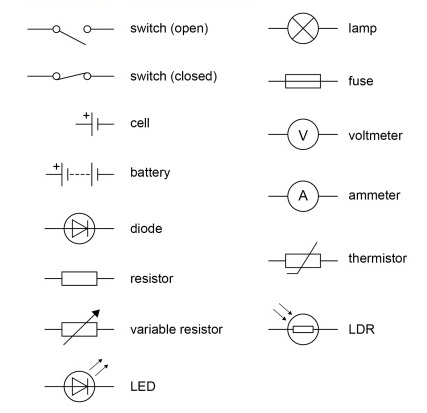Introduction to Charge, Current and Potential Difference
What is an electric current?
An electric current is a flow of charge.
But what is "charge" and what is meant by a "flow of charge" ?
For a long time, Physicists didn't know the answer to the question, what is charge. All they knew was that something flowed when there was an electric current. And for want of a better word, they called that something, charge!
But now we know what actually flows when we have an electric current, so now we know the answer to the question, what is charge.
Charges are electrons. So, a flow of charge is a flow of electrons.
These are the same electrons that you will know are present in all atoms.
Now that you know that an electric current is a flow of charge, which is a flow of electrons, you should be able to figure out why it is that electrical circuits (whether complex ones like those in computers, or simple ones like those in a table lamp or a torch) always use metal wires to form the circuits (to join up all the components).
The reason is that all metal atoms have an abundance of free electrons which can be made to flow, making the electric current.
This is why we say that "metals are good conductors of electricity", because they have an abundance of free electrons which can be made to flow.
Materials such as plastics, which don't have atoms with free electrons, are not used to make circuits and we describe them instead as "good insulators of electricity".
So, a piece of metal wire is ideal for carrying an electric current; it is literally full of electrons. We can think of them, as in the following diagram, like cars, bumper to bumper.
The electrons in the wire above are not moving or flowing, so there isn't a current.
What else is needed in order to produce the electric current, to make the electrons or charges flow?
To produce an electric current in the wire, there must be a Potential Difference across the wire.
Batteries and mains electricity are two sources of Potential Difference.
In the following diagram a battery is being used as a source of potential difference and it is connected across the piece of wire.
The battery seems to push on just one electron, but since the electrons are "bumper to bumper" in the wire, like the cars, they ALL move through the wire as shown by the arrows in the diagram.
The best way to think of the source of p.d (potential difference) is as a pump.
Just as a water pump takes in water at one end and pushes it out at the other end, so our source of p.d takes in the electrons/charge at one end and pushes them out at the other end, causing all of the electrons in the circuit to move or flow at the same time! It is important to understand this.
As long as the source of p.d remains doing its job, the electrons keep flowing and we have a steady electric current flowing all the way around the circuit.
Note: The last 6 words in Bold are really important; the current flows steadily, continuously, all the way around the circuit, through whatever components are in its way. So whatever is the size of the current leaving one side of the p.d source will be the size of the current entering the other side of the p.d source. More on this later.
So, to summarise:
- An electric current is a flow of charge.
- Charges are electrons, so an electric current is a flow of electrons.
- Metal wires are used in electrical circuits because they contain an abundance of free electrons, making them good conductors.
- To make the electrons flow through a circuit, such as a piece of wire, a souce of Potential Difference (p.d) is neeeded.
- The source of p.d acts like a pump, taking in electrons and pushing them out, making them move or flow through the circuit, creating the electric current which flows continuously all the way round the circuit.
Before we end this introduction, let's take the opportunity to talk about 3 things mentioned in the above summary list that can be measured.
These are the size of electric current, the quantity of charge and the potential difference (also known as voltage).
The size of electric current is given the symbol "I" and it is measured in units called amperes or amps or A.
eg I = 3 amperes, I = 3 amps, I = 3 A, all mean that the size of the current is three amperes.
The quantity of charge is given the symbol Q, for Quantity. It is measured in units called coulombs or C.
eg Q = 1200 coulombs, Q = 1200 C, both mean that the quantity of charge that has flowed is 1200 coulombs
The potential difference or voltage is given the symbol V. It is measured in units called volts, which unfortunately also has the symbol V.
eg V = 10 volts, V = 10 V, both mean that the voltage or potential difference is ten volts.
This is enough for our introduction.
